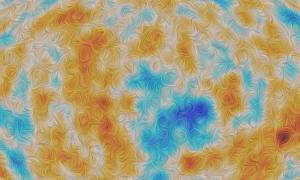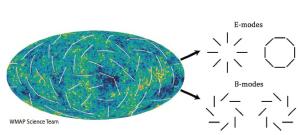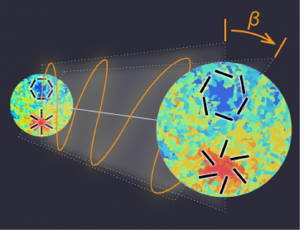Blog
Cosmic Twist
30 November 2020
 ESA/Planck Collaboration
ESA/Planck CollaborationThe oldest light in the universe is that of the cosmic microwave background (CMB). This remnant glow from the big bang has traveled for more than 13 billion years. Along the way, it has picked up a few tales about the history and evolution of the cosmos. We just need to listen to what it has to say.
One of the ways the CMB tells a story is through its polarization. If you think of light as an oscillating wave, then this wave motion can have different orientations, the orientation of a light wave’s oscillation is known as its polarization. Often, light is a random jumble of orientations, making it unpolarized, but the light from the CMB is light that has scattered off the hot gas of the early universe and has an orientation known as E-mode polarization.
 WMAP Science Team
WMAP Science TeamIf there were nothing but empty, flat space between us and the cosmic microwave background, then all the light from the CMB would be E-mode polarized. But deep space isn’t empty. It’s filled not only with diffuse gas and dust, but also dark matter and dark energy. As the light from the big bang travels through this, its polarization changes slightly, twisting through an angle, β. This shifts the orientation of CMB light toward B-mode polarization.
 Y. Minami / KEK
Y. Minami / KEKStudying this effect is very difficult, partly because the shift is so small, and partly because the source of the shift is difficult to pin down. But recently a team set out to learn more about it.1 Using data from the Planck satellite survey, they analyzed the B-mode polarization using a new method that cuts down on background noise. They were able to measure a small shift in the polarization, known as cosmic birefringence.
It’s possible that the observed shift is just due to systematic errors in their measurement, but the team determined that the effect is real to 99.2% likelihood. That isn’t high enough to confirm the effect, but it is high enough to merit further study. If the effect is confirmed, it could point to a new understanding of dark matter.
 Siora Photography @siora18
Siora Photography @siora18Cosmic birefringence would point to a lack of symmetry known as parity. When matter has parity, an object and its mirror image behave in the same way. For example, a person’s left and right hands are mirror images and can move in the same way, thus they have parity. Our hearts are on the left, not the right, thus they violate parity. Regular matter is symmetrical in the way it interacts with CMB light, so it doesn’t cause cosmic birefringence. But perhaps dark matter does. This would be a new effect not seen with dark matter and would point to physics beyond the standard model.
It’s still too early to tell whether this is a new clue for dark matter. Other phenomena such as early cosmic inflation could also induce B-mode polarization in CMB light. But this study shows the effect can be measured, and that gives us hope that we will one day understand it.
Minami, Yuto, and Eiichiro Komatsu. “New Extraction of the Cosmic Birefringence from the Planck 2018 Polarization Data.” Physical Review Letters 125.22 (2020): 221301. ↩︎